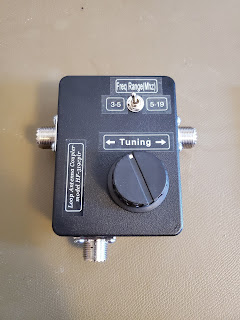Antennas4Less HF-319 Initial Impressions (And Going Outside)
I picked up the Antennas4Less HF-319 (archived) on a savings deal a couple weeks ago to give me a better option over the MJF-1899T for compact HF operating. With weather outside being excellent this weekend in Wisconsin and wanting to get a little practice in for the Wisconsin QSO party coming up next weekend, I went out with the antenna and my FT-818nd.
It was a bit of a hike out to the park and the trails were packed snow/ice, but there was a convenient table available on the higher side of the park field. Tuning up on 20m with my NanoVNA worked as expected and. . . oh yeah, it's a SSB contest weekend. Oops. The band was packed to the gills with voices from all over. However, I got the new experience of tuning up to a S0- noise floor, much improved over the S8 that I get in my apartment.
Needless to say, trying to schedule a contact over Discord on 20m was futile with the number of signals on the contest-allowed band and tuning over to 17m resulted in a bit of shouting into the void before packing up to beat sundown. Hearing the band conditions in a quiet environment was still nice as was getting practice with the kit.
 |
| HF-319 with the evening's contrails in the sunset |
Operating the HF-319 is pretty simple with a band range switch and the air variable capacitor knob. Unpracticed setup and tuning takes a few minutes and could be improved by better packing of the components. As expected at this price range, the knob is directly coupled and thus extremely touchy for getting on-frequency. However, upgrading it with a decent reduction knob mechanism would add $40+ to its already low price. Still, I might attempt the upgrade at some point. Tuning for noise is almost impossible in the quiet RF environment of the park, so the NanoVNA is quite handy to get the TX tuning set correctly.
 |
| The HF-319 Tuning Box Front Case |
Taking a look inside the device previously, this is a straightforward small magnetic loop antenna tuner with a ferrite toroid for signal coupling into the transmitting loop. This provides some impedance transformation and eliminates the additional coupling loop required by other magnetic loop transmitting antennas. Not needing an additional dangly bit in the kit helps a lot, though obviously increases the complexity of the contents of the box.
 |
| Inside the Tuning Box |
I almost certainly need more practice (and to actually make an HF contact in over 5 years), but this is progress over sitting down in the W8EDU club station and "just" hitting the Caribbean by hitting a few buttons and setting the right switches. Getting the right pack to move the gear will also be necessary. The significant other helped out by carrying the tripod, but I will eventually need everything to stack on just me.


Comments
Post a Comment